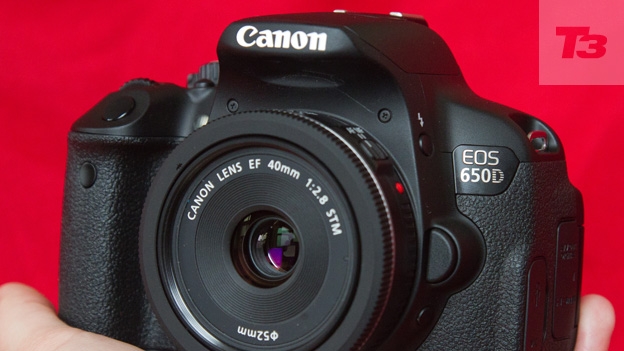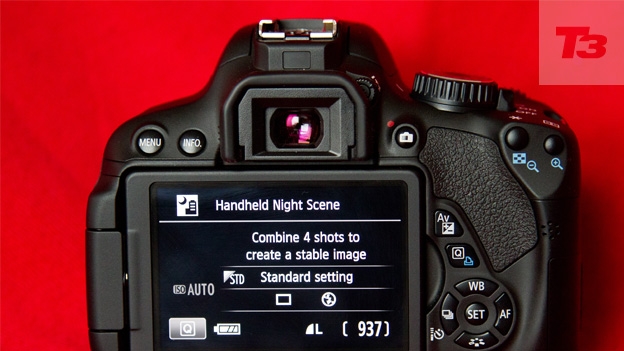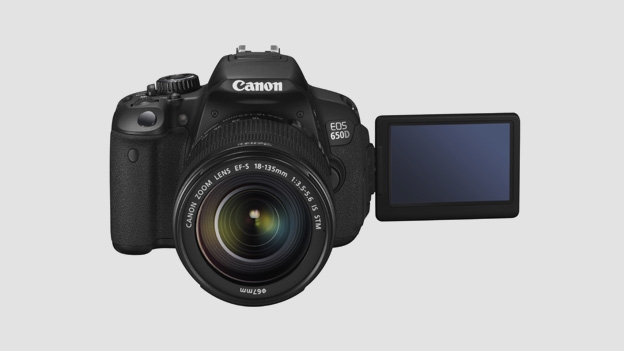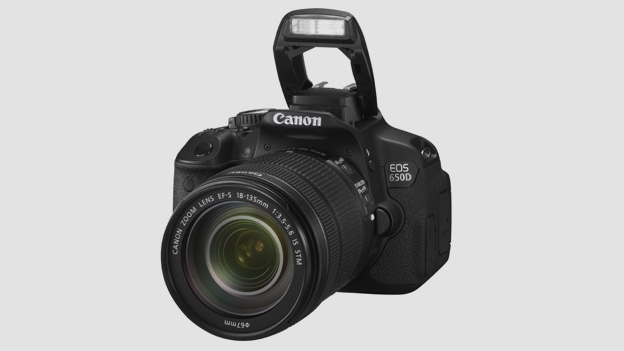Canon EOS 650D review
The Canon EOS 650D entry-level DSLR brings touch screen control to the party


-
+
Touch-screen LCD
-
+
5fps
-
+
Image quality and high ISO
-
-
Quite pricey
-
-
Touch-screen needs to be clean
-
-
Mixed materials on body
Why you can trust T3





The Canon EOS 650D entry-level DSLR packs an 18-megapixel sensor and brings touchscreen control to the party but can it rival the Nikon D3200?
The new Canon EOS 650D is a user-friendly enthusiast-level D-SLR full of new tech and functions, including a new touch-screen, and much more than a simple upgrade from the Canon EOS 600D (which it now sits above in the range). As well as helpful intelligent auto modes there are a wealth of advanced features available as your camera skills and photography progresses.
The EOS 650D (Rebel T4i in North America) is equipped with a new 18-megapixel Hybrid CMOS sensor and powerful Digic 5 processor, that enables you to capture excellent, full-resolution images at up to five frames per second (fps).
The EOS 600D only manages 3.7fps, while the Nikon D3200 rattles off 4fps, making the Canon EOS 650D ideal for keeping up with the action and sport this summer.
Canon EOS 650D: Screen
What makes this Canon camera different is that it's the first-ever D-SLR to feature a touch-screen. We've grown to expect smartphones, tablets and some compact cameras to have touch-screen control, but this is big move for Canon's D-SLRs, and is set to revolutionise the D-SLR industry. The Canon EOS 650D has a touch-screen Vari-angle 3-inch Clear View II TFT, approx. 1040K dots.
From a tap of the screen (tap the Q button when shooting info is displayed on the LCD), you can quickly adjust all your camera settings – from aperture and shutter speed to white balance and drive and focusing modes, and many more accessed via the menus.
But better still, when using Live View (to shoot via the LCD instead of the viewfinder), in the new Touch Shutter mode you can simultaneously focus and shoot at the touch of the screen. You simply tap the LCD to focus on an area or subject in your scene, as soon as the autofocus is locked on, the 650D automatically takes a shot.
It's during Live View that the touch-screen really shows off – you can select AF points, track people's faces and objects, and fine-tune your exposure settings. There are four AF modes in Live View to help you do this; Face Recognition + Tracking, FlexiZone – Multi, FlexiZone – Single, and Quick Mode.
We found the face recognition mode worked great as you can easily tap the screen to select the person you want to focus on; while the FlexiZone is great for covering a larger area of the frame than you can with the standard nine AF points you see through the viewfinder.
Canon EOS 650D: Controls
You can also swipe and pinch-zoom on the touch-screen (as you would on an iPhone or iPad) which makes it faster and fun when you're reviewing your images.
Canon has realised that not all people like using touch-screens, however, and so the 650D has controls and buttons if you prefer to use them as on other EOS cameras. You can also turn off the touch-screen function if you prefer.
We loved using the touch-screen and found it responsive and intuitive to use, although we found it quickest to use a combination of dials and the touch-screen.
In case you're wondering, the touch-screen automatically switches off when you raise the Canon EOS 650D to your eye, so you won't tweak settings with your nose while you're taking pictures.
The EOS 650D (like the Canon EOS 600D, but unlike the normal LCD on the Nikon D3200) also has a Vari-angle LCD, which helps when shooting at awkward angles, up high or low down, and you can flip it round for some fun self-portraits.
In terms of looks and feel, the EOS 650D is almost identical to the 600D, and there are only a few small button changes: the Menu and Info buttons are circular, and you can switch to either On, Off or Movie mode straight from the On/Off switch.
Canon EOS 650D: Image sensor
The 650D has an 18-megapixel sensor (which is big enough for most of our needs, unless you're a pro photographer who needs to print posters) like many other EOS cameras, and although the Nikon D3200 may have a bigger 24-megapixel sensor, the 650D has a new Hybrid CMOS sensor that incorporates a new combined phase detection and contrast detection AF (autofocus) system, which operates during video recording and when Live View is activated.
What this means to you and us, is that you're able to focus continuously in movie mode. This is thanks to clever on-sensor pixels. When the Canon 650D focuses in Live View or video mode it uses the sensor phase detection system to get an initial lock on your subject or scene, then the contrast detection helps to ensure it's sharp and properly in focus.
Like the 600D, in normal shooting mode the 650D uses nine-point phase detection AF. However, all of these points are cross-type on the 650D - the 600D only has one cross-type AF point, at the centre of the frame – so you'll increase your success rate when focusing with the 650D's new AF system.
From our tests in a variety of lighting conditions, the AF was mostly on the money during Live View or when recording videos. In darker lighting conditions, it hunted around back-and-forth until locking the AF.
Canon EOS 650D: Image Quality
Straight out of the camera, the EOS 650D take brilliant photos. Images are full of contrast and colourful, but not unnaturally so, or overly saturated which can be the case with other similarly priced D-SLRs. The Canon 650D also coped well when shooting in difficult lighting conditions, such as into the sun, and still managed to capture good detail in both the shadows and highlights.
Canon EOS 650D: ISO performance
Compared to the EOS 600D and Nikon D3200, the EOS 650D gets one more stop in the ISO stakes – the basic range is ISO100- 12,800, but this can be expanded to ISO25,600, not bad for a beginner/enthusiast D-SLR.
Although, as we've come to expect, images shot at the maximum ISO25600 were noisy and lacking definition and colour, at ISO12800, images are certainly useable and impressively detailed, and smoother still if you use the in-camera noise reduction settings.
Under the High ISO Speed NR menu setting are four main Noise Reduction settings (Off, Low, Standard and High – also found on the EOS 600D), we found the High setting was pretty effective at reducing noise levels of images in-camera.
The EOS 650D also gets a new Multi-Shot Noise Reduction setting, which automatically take four shots in succession and combines them together to create one low-noise image. We found this worked even better at reducing noise in-camera compared to the basic High NR setting.
Below ISO12800, and image noise is hardly noticeable unless you're zooming in at 100% view. We found it a real bonus being able to shoot handheld at ISO6400 in low light indoors. At any ISO setting between 100-3200 you'll find images free from any noise or loss of quality.
Canon EOS 650D: HD Video
For home movie fans, you can record Full HD (1920x1080p) movies with full manual control of exposure and frame rates of 30, 25 and 24 fps at full resolution, with 60 and 50 fps available at 720p resolution. The EOS 650D also gets a new built-in stereo microphone for improved sound recording.
Canon EOS 650D: Features
Canon has also introduced two new scene shooting modes with the 650D: Handheld Night Scene and HDR Backlight Control. Both of which are there to help you when shooting in tricky lighting conditions, and both take a sequence of shots and combine them in-camera for a better result.
Although we found both to take lacklustre results – in HDR Backlight Control mode the results appeared hardly enhanced compared to a standard exposure, while the Handheld Night Scene essentially just boosts the ISO setting (to around 5000 or 8000) to ensure you get a sharp (yet noisy) shot at night.
Canon has also added two new Creative filters, Art Bold and Water Painting Effect, which can be applied when reviewing images. Although we found both of these pretty garish.
Canon EOS 650D: Verdict
The Canon EOS 650D has taken beginner-enthusiast D-SLRs to the next level. Although it 'only' has an 18-megapixel sensor, image quality is great, and high ISO performance is strong. Thanks to the Digic 5 processor, it will also blast off 5fps to help you keep up with fast-moving subjects. Plus there's the lovely adjustable touch-screen tech to enhance the user experience.
Although it's overflowing with functions and features, there's still lots of easy auto and scene modes to do the hard work for you if you prefer.
The only big downer is the price (at £699 RRP for the body), but it's priced about right for the amount of technology you're getting inside such a handy little package, and prices will come down slowly but surely.
Canon EOS 650D availability: Available now
Canon EOS 650D price: £699 RRP (body only), £799 with Canon EF-S 18-55mm f/3.5-5.6 IS II kit lens
Review by Peter Travers
Sign up to the T3 newsletter for smarter living straight to your inbox
Get all the latest news, reviews, deals and buying guides on gorgeous tech, home and active products from the T3 experts
T3.com is one of the UK's leading consumer lifestyle websites, visited by over 10 million people every month. You can follow us on Twitter, Facebook and Instagram. We present products in helpful buying guides and carefully curated deals posts across style, living, auto, smart home, watches, travel, fitness and more. We also have a monthly magazine which you can buy in newsagents or subscribe to online – print and digital versions available.
-
 Warning: Ciele’s refreshed Elite Collection may cause excessive garment envy on race day
Warning: Ciele’s refreshed Elite Collection may cause excessive garment envy on race dayFlex on your run crew with Ciele’s latest drop
By Matt Kollat Published
-
 Smeg adds a touch of navy sophistication to its iconic breakfast set
Smeg adds a touch of navy sophistication to its iconic breakfast setIt's a minimalist's dream
By Lizzie Wilmot Published
-
 My most anticipated Netflix movie of the year gets a wild new trailer
My most anticipated Netflix movie of the year gets a wild new trailerHavoc looks pretty unbelievable
By Max Freeman-Mills Published
